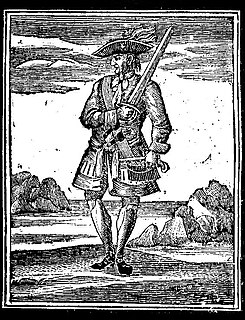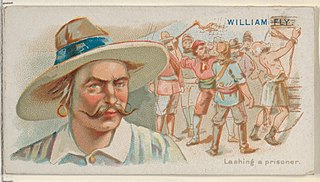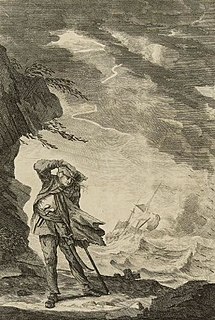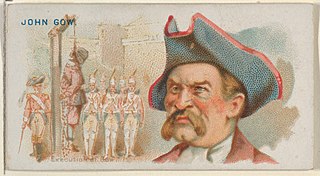Related Research Articles

William Kidd, also known as Captain William Kidd or simply Captain Kidd, was a Scottish sea captain who was commissioned as a privateer and had experience as a pirate. He was tried and executed in London in 1701 for murder and piracy.

Hanging is the suspension of a person by a noose or ligature around the neck. The Oxford English Dictionary states that hanging in this sense is "specifically to put to death by suspension by the neck", though it formerly also referred to crucifixion and death by impalement in which the body would remain "hanging". Hanging has been a common method of capital punishment since medieval times, and is the primary execution method in numerous countries and regions. The first known account of execution by hanging was in Homer's Odyssey. In this specialised meaning of the common word hang, the past and past participle is hanged instead of hung.
Capital punishment in the United Kingdom was used from ancient times until the second half of the 20th century. The last executions in the United Kingdom were by hanging, and took place in 1964, before capital punishment was suspended for murder in 1965 and finally abolished for murder in 1969. Although unused, the death penalty remained a legally defined punishment for certain offences such as treason until it was completely abolished in 1998; the last execution for treason took place in 1946. In 2004 the 13th Protocol to the European Convention on Human Rights became binding on the United Kingdom, prohibiting the restoration of the death penalty for as long as the UK is a party to the convention.

John Rackham, commonly known as Calico Jack, was an English pirate captain operating in the Bahamas and in Cuba during the early 18th century. His nickname was derived from the calico clothing that he wore, while Jack is a nickname for "John".

Mary Read, also known as Mark Read, was an English pirate. She and Anne Bonny are two famous female pirates from 18th century, and among the few women known to have been convicted of piracy at the height of the "Golden Age of Piracy".

A gibbet is any instrument of public execution, but gibbeting refers to the use of a gallows-type structure from which the dead or dying bodies of criminals were hanged on public display to deter other existing or potential criminals. Occasionally, the gibbet was also used as a method of execution, with the criminal being left to die of exposure, thirst and/or starvation. The term gibbet may also be used to refer to the practice of placing a criminal on display within a gibbet. This practice is also called "hanging in chains".
Captain Benjamin Hornigold (1680–1719) was an English pirate who operated during the tail end of the Golden Age of Piracy.

Anne Bonny, sometimes Anne Bonney, was an Irish pirate operating in the Caribbean, and one of a few female pirates in recorded history. What little that is known of her life comes largely from Captain Charles Johnson's A General History of the Pyrates.

William Fly was an English pirate who raided New England shipping fleets for three months in 1726 until he was captured by the crew of a seized ship. He was hanged in Boston, Massachusetts and his body publicly exhibited as a warning to other pirates. His death is considered by many to mark the end of the Golden Age of Piracy.

Benito de Soto Aboal was a Galician pirate, and captain of the Burla Negra.
Thomas Green (1679/1680[?]-1705) was an English sailor and alleged pirate, who was captain of the Worcester. He was hanged on Leith sands in Scotland along with two of his crew on 11 April 1705.

Edward "Ned" Low was a notorious pirate of English origin during the latter days of the Golden Age of Piracy, in the early 18th century. Low was born into poverty in Westminster, London and was a thief from an early age. He moved to Boston, Massachusetts as a young man. His wife died in childbirth in late 1719. Two years later, he became a pirate, operating off the coasts of New England and the Azores, and in the Caribbean.

John Gow was a notorious pirate whose short career was immortalised by Charles Johnson in the 1725 work The History and Lives of All the Most Notorious Pirates and Their Crews. Little is known of his life, except from an account by Daniel Defoe, which is often considered unreliable, the report on his execution, and an account by Mr. Alan Fea, descendant of his captor, published in 1912, almost two centuries after his death.

Richard Worley was a pirate who was active in the Caribbean Sea and the east coast of the American colonies during the early 18th century.
Charles Harris (1698-1723) was an English pirate active in the 1720s. He is best known for his association with George Lowther and Edward Low.
John Vidal was a minor Irish-American pirate briefly active near Ocracoke Inlet off North Carolina. He is best known for bringing the Farley family with him, causing wife Martha Farley to be one of the few women tried for piracy.

Philip Lyne was a pirate known for his cruelty and his association with Francis Spriggs.

Philip Roche (1693–1723) was an Irish pirate active in the seas of northern Europe, best known for murdering the crews and captains of ships he and his men took over.
Matthew Luke was a pirate active in the Caribbean.
References
- 1 2 Travers, Tim (2012). Pirates: A History. Stroud UK: The History Press. ISBN 9780752488271 . Retrieved 8 August 2017.
- ↑ "Execution of a pirate..." The Post-Boy. Abel Roper. London. 3 August 1728. Retrieved 8 August 2017. Prie's hanging was also reported in the London Journal of 27 July 1728; both were reprinting older news items, as Prie had been hung a year earlier.
- ↑ Lincoln, Margarette (2016). British Pirates and Society, 1680-1730. London: Routledge. ISBN 9781317171676 . Retrieved 8 August 2017.
- ↑ Cordingly, David (2013). Under the Black Flag: The Romance and the Reality of Life Among the Pirates. New York: Random House Publishing Group. ISBN 9780307763075 . Retrieved 28 July 2017.
